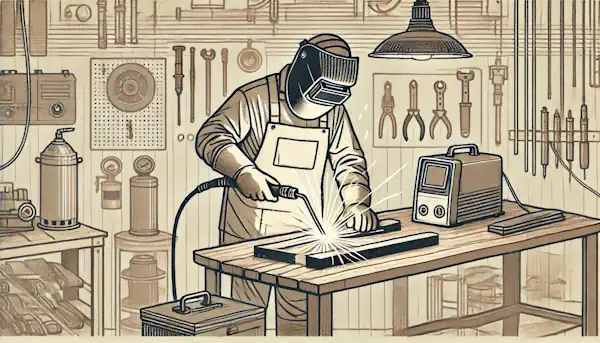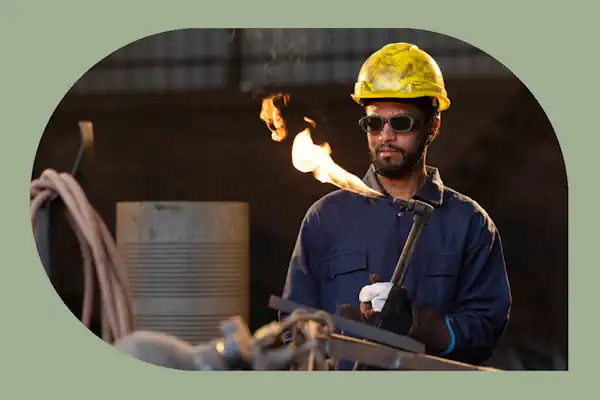Welding is a skilled trade that plays a critical role in various industries, including construction, manufacturing, automotive, and aerospace. Welders are responsible for fusing metal components together, creating strong joints used in everything from buildings and bridges to cars and ships. If you’re interested in working with your hands, have a good eye for detail, and enjoy technical work, becoming a welder could be a rewarding career path.
Requirements to Get into a Welding Program
Most welding programs have minimal entry requirements, making this career accessible to many people. Here’s what you typically need to get started:
- High School Diploma or GED: Most trade schools require applicants to have completed high school or obtained a GED. However, some schools may allow those without these qualifications to enter with additional coursework.
- Basic Math and Reading Skills: Welding involves working with measurements and reading blueprints, so having a solid understanding of math is essential. Some schools may have placement tests to ensure you meet these basic requirements.
- Physical Fitness: Welding can be physically demanding, requiring good hand-eye coordination, steady hands, and the ability to work in different positions for extended periods.
- Age Requirements: Most programs require students to be at least 18 years old, although some high schools offer dual-enrollment programs for younger students.
Average Cost of a Welding Program
The cost of welding programs varies based on the type of school and the program’s length. On average:
- Community Colleges: $5,000 to $15,000 for a certificate or diploma program, lasting 6-12 months.
- Private Trade Schools: $10,000 to $20,000 for shorter, intensive programs that focus specifically on welding.
- Apprenticeships: Often sponsored by unions or employers, apprenticeships can be more affordable, with costs typically covered by the sponsoring organization. However, these programs take longer to complete.
Other costs to consider include tools, protective gear, and textbooks, which could range from $500 to $1,500.
Courses in a Welding Program
Welding programs offer a combination of classroom instruction and hands-on training. Typical courses include:
- Introduction to Welding: Covers the basics of welding equipment, safety procedures, and types of welding methods.
- Blueprint Reading: Teaches students how to interpret welding symbols and technical drawings used in projects.
- Welding Processes:
- Shielded Metal Arc Welding (SMAW): Commonly known as “stick welding.”
- Gas Metal Arc Welding (GMAW): Also called “MIG welding.”
- Gas Tungsten Arc Welding (GTAW): Known as “TIG welding.”
- Flux-Cored Arc Welding (FCAW): A type of welding used in construction and shipbuilding.
- Welding Metallurgy: Focuses on the properties of metals and how different welding techniques impact the strength of materials.
- Welding Safety: Emphasizes the importance of using personal protective equipment (PPE) and following safety protocols.
- Fabrication Techniques: Students learn to cut, shape, and fit metal components to prepare for welding.
Differences Between Learning at Trade School vs Apprenticeship vs On-the-Job Training

There are several ways to become a welder, and each path offers unique benefits:
Trade School
- Structured Learning: Trade school welding programs are well-organized and provide a comprehensive education in welding theory and practical skills.
- Fast Track to Certification: Trade schools typically offer certification programs that can be completed in as little as six months.
- Hands-On Training: You’ll get to practice welding in a controlled environment, learning from experienced instructors.
Apprenticeship
- Real-World Experience: Apprenticeships combine on-the-job training with classroom instruction. You’ll work with a journeyman welder and earn a paycheck while learning.
- Longer Duration: Apprenticeships usually last three to four years, offering deeper expertise in welding but requiring a longer time commitment.
- Paid Training: Unlike trade school, apprenticeships pay you while you learn, making them a more affordable option for many students.
On-the-Job Training
- Learn as You Work: Some companies may hire entry-level workers and provide welding training on the job. This path is typically less formal and slower-paced compared to trade school or apprenticeship.
- No Upfront Costs: You can start earning immediately, though the training may be less comprehensive.
- Limited Certification: Without formal schooling or an apprenticeship, you may miss out on industry-recognized certifications, which can limit job opportunities.
Getting a Job After Graduation
The welding industry is growing, and skilled welders are in high demand. After completing a welding program, there are several steps you can take to increase your chances of landing a job:
- Certification: While not always required, many employers prefer candidates who hold certifications from the American Welding Society (AWS). Certification shows that you’ve met industry standards and can perform various types of welding.
- Building a Portfolio: Document your welding projects throughout your training to showcase your skills to potential employers.
- Networking: Many trade schools and apprenticeship programs have partnerships with local employers. Attend job fairs, trade shows, and industry events to make connections.
- Specialization: Developing expertise in a specific type of welding, such as TIG welding for aerospace or underwater welding, can make you more competitive in niche markets.
- Continuous Education: Technology and techniques in welding are constantly evolving. Continuing education and earning advanced certifications can open doors to higher-paying jobs and more advanced roles.
Forks in the Path
Becoming a welder through trade school is a fast, focused, and structured way to enter the workforce in this rewarding field. Whether you choose trade school, an apprenticeship, or on-the-job training, welding offers a stable career with opportunities for advancement and specialization. With the right training and certification, you can enjoy a long, successful career in welding, contributing to a wide range of industries.
More:
